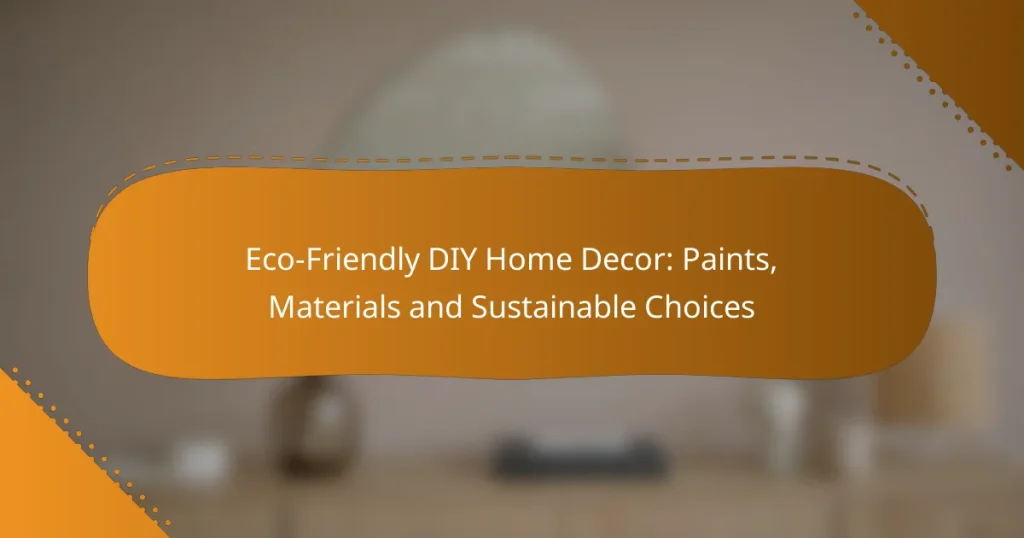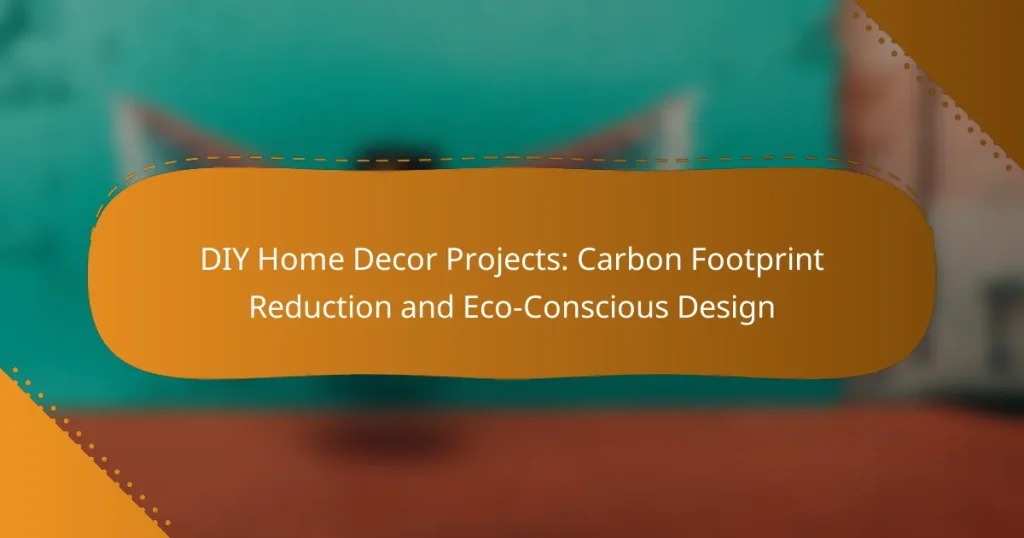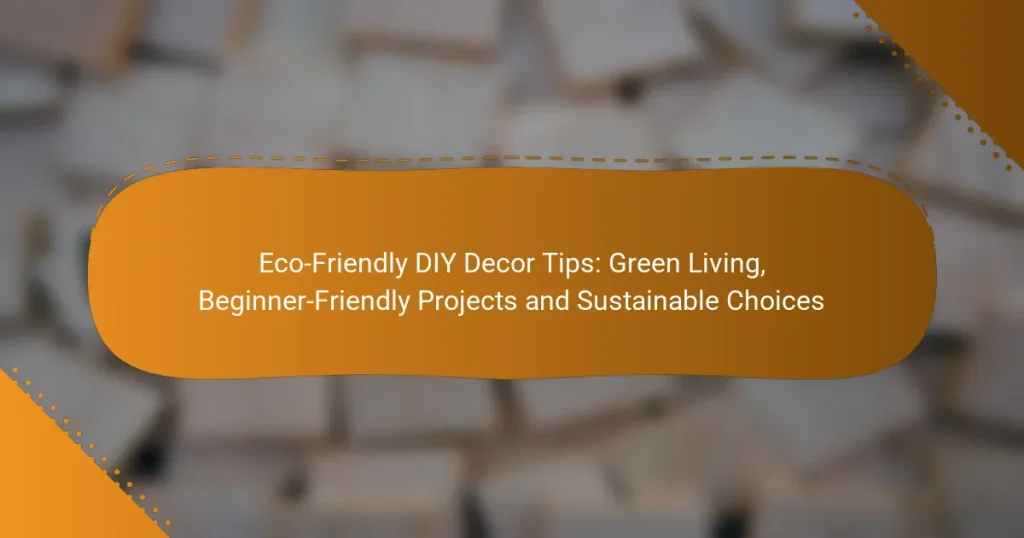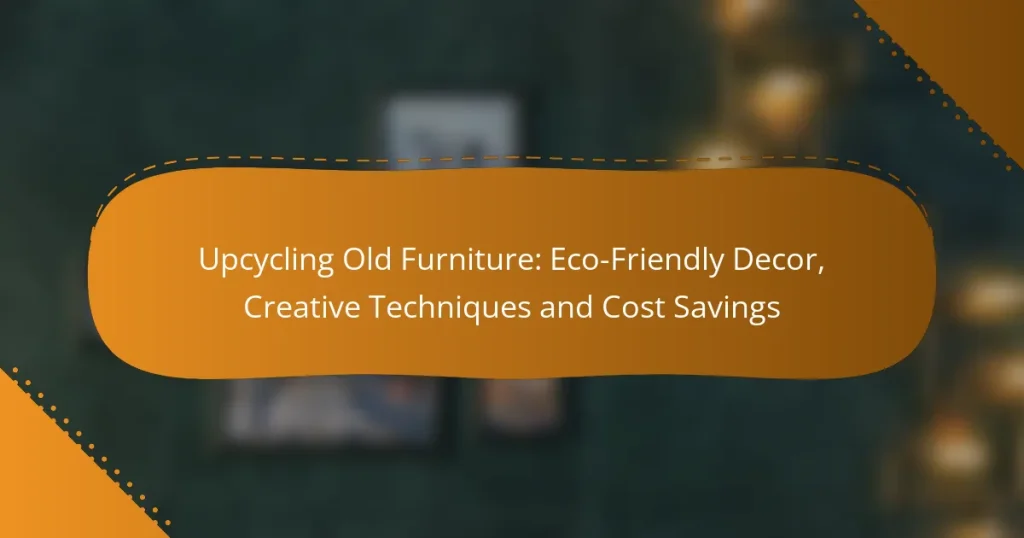Creating eco-friendly DIY home decor is a rewarding way to enhance your living space while being kind to the planet. By utilizing sustainable materials and practices, such as reclaimed items and non-toxic finishes, you can craft beautiful decor that reduces environmental harm and promotes a healthier home. Embrace the art of upcycling and make conscious choices that reflect your commitment to sustainability.
DIY Home Decor Ideas: Sustainability, Aesthetics and Functionality
DIY Home Decor Projects: Carbon Footprint Reduction and Eco-Conscious Design
Sustainable DIY Home Decor: Cost-Effective Solutions and Eco-Friendly Materials
Eco-Friendly DIY Decor Tips: Green Living, Beginner-Friendly Projects and Sustainable Choices
Upcycling Old Furniture: Eco-Friendly Decor, Creative Techniques and Cost Savings
Eco-Friendly DIY Home Decor Projects: Recycled Materials, Sustainable Practices, Budget-Friendly Ideas
How to create eco-friendly DIY home decor?
Creating eco-friendly DIY home decor involves using sustainable materials and practices that minimize environmental impact. Focus on sourcing reclaimed or upcycled items, choosing non-toxic finishes, and incorporating energy-efficient solutions.
Use reclaimed wood for furniture
Reclaimed wood is a sustainable choice for furniture as it repurposes materials that would otherwise go to waste. Look for local suppliers or salvage yards that offer wood from old buildings, barns, or pallets.
When selecting reclaimed wood, check for signs of damage or pests. Treat the wood properly to ensure durability and safety, and consider using it for tables, shelves, or accent pieces.
Incorporate upcycled materials
Upcycling involves transforming discarded items into functional decor. This can include turning glass jars into candle holders or using old fabric for cushion covers.
Be creative with your upcycled projects. For instance, old furniture can be refreshed with new upholstery or paint, giving it a new life while reducing waste.
Choose non-toxic paints and finishes
Opt for non-toxic paints and finishes to ensure a healthier indoor environment. Look for products labeled as low-VOC (volatile organic compounds) or zero-VOC.
These paints not only reduce harmful emissions but also come in a variety of colors and finishes. Always test a small area first to ensure compatibility with your materials.
Utilize natural fabrics
Natural fabrics like cotton, linen, and hemp are biodegradable and often produced with fewer chemicals compared to synthetic options. Choose these materials for curtains, upholstery, and throw pillows.
When purchasing, look for certifications like GOTS (Global Organic Textile Standard) to ensure the fabric meets organic and environmental standards.
Implement energy-efficient lighting
Energy-efficient lighting, such as LED bulbs, can significantly reduce energy consumption in your home. These bulbs last longer and use a fraction of the energy compared to traditional incandescent bulbs.
Consider installing dimmer switches or smart lighting systems to further enhance energy savings. This not only helps the environment but can also lower your electricity bills over time.
What are the benefits of eco-friendly home decor?
Eco-friendly home decor offers numerous advantages, including reduced environmental harm and enhanced well-being. By choosing sustainable materials and practices, homeowners can create a healthier living space while contributing positively to the planet.
Reduces environmental impact
Using eco-friendly materials minimizes waste and conserves natural resources. For example, reclaimed wood and recycled metals reduce the need for new materials, which often involve energy-intensive extraction and processing.
Additionally, many eco-friendly products are designed to be biodegradable or recyclable, further decreasing landfill contributions. Opting for local artisans can also cut down on transportation emissions, making a significant difference in your carbon footprint.
Improves indoor air quality
Eco-friendly home decor often features low-VOC (volatile organic compounds) paints, finishes, and furnishings, which help maintain better indoor air quality. Traditional materials can release harmful chemicals that contribute to respiratory issues and other health problems.
By selecting natural textiles and organic materials, homeowners can create a space that is not only aesthetically pleasing but also healthier for occupants. Plants can also play a role; incorporating greenery into decor can naturally purify the air and enhance overall well-being.
Supports sustainable practices
Choosing eco-friendly decor supports sustainable practices by promoting responsible sourcing and manufacturing. Many companies that produce these items prioritize ethical labor practices and environmentally conscious production methods.
Homeowners can further this commitment by supporting local businesses and artisans who focus on sustainability. This not only boosts the local economy but also encourages a culture of environmental responsibility within the community.
Where to find eco-friendly DIY materials?
Finding eco-friendly DIY materials is essential for creating sustainable home decor. Look for sources that prioritize recycled, reclaimed, or sustainably sourced products to minimize environmental impact.
Local thrift stores
Local thrift stores are excellent places to find unique and affordable materials for your DIY projects. You can discover furniture, decor items, and fabrics that can be repurposed or upcycled into something new.
When shopping at thrift stores, check for items that may need a little TLC, such as a coat of paint or new upholstery. This not only saves money but also reduces waste by giving items a second life.
Online marketplaces like Etsy
Online marketplaces like Etsy offer a wide range of eco-friendly materials from independent sellers. You can find handmade items, vintage pieces, and sustainable supplies that cater to various DIY needs.
When purchasing from these platforms, look for sellers who emphasize sustainable practices and materials. Reading reviews and checking for certifications can help ensure you are supporting eco-conscious businesses.
Home improvement stores with green sections
Many home improvement stores now feature dedicated sections for eco-friendly products. These areas typically include sustainable paints, reclaimed wood, and energy-efficient fixtures, making it easier to find materials that align with your values.
Before making a purchase, compare options within the green section to find the best balance of quality and price. Look for certifications like Green Seal or Energy Star to ensure that the products meet environmental standards.
How to choose sustainable decor options?
Choosing sustainable decor options involves selecting items that are environmentally friendly, ethically sourced, and made to last. Focus on materials that minimize environmental impact and brands that prioritize sustainability in their practices.
Evaluate material sourcing
Material sourcing is crucial when selecting eco-friendly decor. Look for items made from renewable resources, such as bamboo or reclaimed wood, which reduce deforestation and waste. Avoid products made from harmful substances like PVC or synthetic fibers that can release toxins.
Check for certifications such as FSC (Forest Stewardship Council) for wood products or GOTS (Global Organic Textile Standard) for textiles. These labels indicate responsible sourcing and production practices.
Consider durability and lifespan
Durability is a key factor in sustainable decor, as longer-lasting items reduce the need for replacements and waste. Opt for high-quality materials that can withstand wear and tear, such as solid wood or metal, rather than cheaper, disposable options.
When assessing lifespan, think about how often you might need to replace an item. Investing in timeless designs that can adapt to changing styles can also contribute to sustainability by minimizing the frequency of purchases.
Research brand sustainability practices
Understanding a brand’s sustainability practices helps ensure your purchases align with eco-friendly values. Investigate whether brands use ethical labor practices, environmentally friendly production methods, and transparent supply chains.
Look for brands that actively engage in sustainability initiatives, such as carbon offset programs or community support. Reading customer reviews and third-party assessments can provide insights into a brand’s commitment to sustainability.
What are popular eco-friendly DIY projects?
Popular eco-friendly DIY projects focus on repurposing materials and reducing waste while enhancing home aesthetics. These projects not only promote sustainability but also allow for creativity and personalization in home decor.
Upcycled pallet furniture
Upcycled pallet furniture involves transforming wooden pallets into functional pieces like tables, chairs, or shelves. This approach is cost-effective as pallets are often available for free or at a low cost from local businesses.
When creating pallet furniture, ensure the wood is safe for indoor use by checking for chemical treatments. Sanding and sealing the wood can enhance durability and appearance. Consider using non-toxic finishes to maintain an eco-friendly approach.
DIY planters from recycled containers
DIY planters made from recycled containers are an excellent way to give new life to items like old cans, bottles, or jars. These planters can be customized to fit any space, from small windowsills to larger garden areas.
To create a planter, ensure the container has drainage holes to prevent waterlogging. Decorate with paint or natural materials to enhance visual appeal. Using biodegradable materials like cardboard or paper for smaller plants can further support eco-friendliness.
Homemade natural wall art
Homemade natural wall art can be crafted using materials like leaves, branches, or stones, promoting a connection with nature. This type of decor is not only unique but also reduces reliance on commercially produced art.
Gather natural elements during walks or hikes, and consider pressing flowers or leaves for a flat design. Arrange these items in frames or create collages on canvas. Using non-toxic adhesives and paints will keep the project environmentally friendly.
How to maintain eco-friendly decor?
Maintaining eco-friendly decor involves using sustainable practices and products that minimize environmental impact. Regular cleaning and upkeep with natural materials can enhance the longevity and aesthetic of your home while supporting a healthier planet.
Use natural cleaning products
Natural cleaning products are essential for preserving eco-friendly decor. These products are typically made from plant-based ingredients and avoid harsh chemicals, making them safer for both your home and the environment.
When selecting natural cleaners, look for those that are biodegradable and free from synthetic fragrances or dyes. Common options include vinegar, baking soda, and essential oils, which can effectively clean surfaces without harmful residues.
To maintain your eco-friendly decor, create a simple cleaning routine using these natural products. For example, mix equal parts of vinegar and water for a versatile surface cleaner, and use baking soda for scrubbing tough stains. Avoid products with excessive packaging to further reduce waste.






